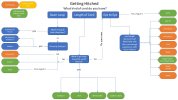casts_by_fly
Well-Known Member
Hi Gents,
What's the right rope for friction hitches for 9 mm C-IV? I'm currently using (or formerly now) 6 mm rope that I've come to learn is actually accessory cord and in no way the right thing to use. I've got a length of Sterling 6mm TRC from making some Oplux tethers which I think I'll use for the rest of the season, but is there a better choice?
thanks,
rick
What's the right rope for friction hitches for 9 mm C-IV? I'm currently using (or formerly now) 6 mm rope that I've come to learn is actually accessory cord and in no way the right thing to use. I've got a length of Sterling 6mm TRC from making some Oplux tethers which I think I'll use for the rest of the season, but is there a better choice?
thanks,
rick


